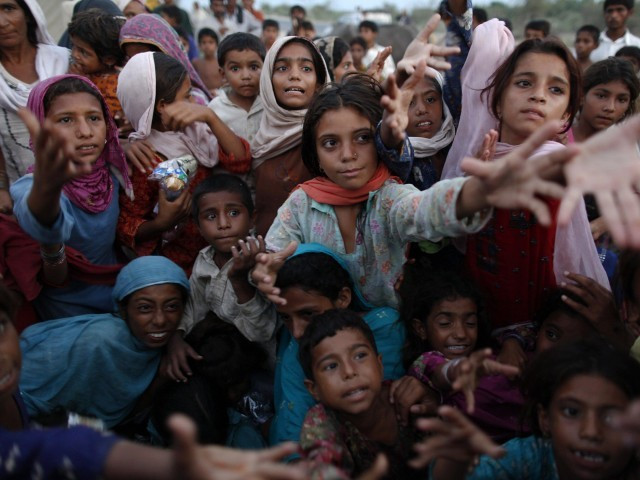As climate policy largely focuses on agriculture and infrastructure, children who suffer remain on the sidelines
LAHORE:
The term “climate change” usually brings to mind flooded plains, destroyed crops and lost livelihoods. Yet the true victims of natural disasters are the children whose hopes for the future are washed away by melting glaciers.
Fourteen-year-old Ayesha has witnessed climate disasters terrible enough to drain the colors of life from her eyes. Standing on the roof of her home in Lahore’s Theme Park area, she looks up at the sky, not to find the sun, but to see nothing but a yellow haze. As Lahore’s smog season kicks in, even breathing feels difficult.
Ayesha is one of the millions of Pakistani children who are the earliest and most vulnerable victims of climate change. Like her house, her school was also destroyed in the recent floods. She is now studying in a temporary school, but she fears her classes may be suspended again when the smog returns. “I want to study. But sometimes the floods come and other times the smog sets in,” Ayesha complained.
Clinical psychologist Fatima Tahir explained that environmental disasters, displacement and economic hardship have profoundly affected children’s mental health. “Anxiety, depression and post-traumatic stress rise sharply in flood and smog-affected communities. Almost half of the affected children struggle with sleep, focus and confidence,” said Tahir.
Pakistan’s climate struggles have become a full-blown crisis. Record high temperatures, unprecedented floods and extended smog seasons have eroded the childhoods of countless children. Yet most national and provincial climate policies remain focused on energy, agriculture and infrastructure, without mentioning children.
Surprisingly, Punjab’s Child Protection & Welfare Bureau appears to have no defined role in protecting children from climate-related harm. Iftikhar Mubarak, executive director of Search for Justice, believed that provincial governments must urgently develop child-centred climate action plans with clear targets, timelines and dedicated budgets. “We don’t need statements, we need results. We must think about how children can survive, learn and stay safe in a changing climate,” Mubarak pleaded.
According to Rashida Qureshi, a child protection activist, climate change intensifies not only physical but also social risks for children. “When families are forced to migrate, children, especially girls, face greater risks of violence and exploitation. In Pakistan, child protection frameworks and climate policies operate in silos, leaving children vulnerable and unprotected at the policy level,” Qureshi said.
The World Health Organization (WHO) reports that 36 percent of diseases among children in Pakistan are linked to environmental factors. Without investments in clean water, clean air and proper sanitary systems, neither children’s health nor the country’s future can be secured.
Dr. Rabia Chaudhry, a public policy expert at Forman Christian College University, called this a neglected dimension of Pakistan’s political landscape. “Climate change is often seen through the lens of roads, dams and energy projects, while its human toll, especially on children, is overlooked. Until government, civil society and academic institutions collaborate on research and dialogue, child-sensitive climate policy will remain out of reach,” noted Dr. Chaudhry.
Legal Adviser to the National Commission on Child Rights, Sheherazade Amin, while referring to the strategic plan of the commission, noted that climate change had now been incorporated into the core mandate of the commission.
“The climate impacts are not equal, as girls suffer the most. Floods and pollution have weakened access to education and health care, while at the same time increasing the risk of early marriage and forced labour. Without including girls in decision-making, no sustainable solution is possible,” said Amin.
As dusk descends, Ayesha climbs down from the roof. The smog has thickened, but she raises her hands to the sky as if reminding it of a promise. “If everyone works together, maybe tomorrow’s sky will be blue,” she murmured. Perhaps her simple hope is the spark from which a safer, brighter Pakistan can emerge.



